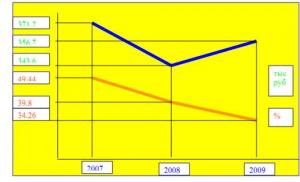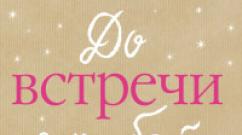Complex names and numerals examples. Numerals
Denoting quantity or a quantitative attribute, the order of an object when counting, answers the questions “which?”, “how much?”.
The numeral is independent part speech, denoting quantity and expressing this meaning in the morphological categories of case (consistently) and gender (inconsistently) (for numerals that have the morphological meaning of gender, see below). Numerals are divided into two lexico-grammatical categories: quantitative ( two, five, twenty, fifty, two hundred, three hundred fifty one) and collective ( both, two, five). The composition of cardinal numerals includes definite-quantitative and indefinite-quantitative numerals. The first ones denote a certain number of units ( two, four, fifteen, one and a half hundred, two hundred), the second - an indefinite number of units; these include words few, a lot, a lot of, A little, as well as pronominal numerals some, How many, for some time, how much, so many, so much.
Cardinal number
Cardinal number- a numeral that answers the question “how much?”, “how many?” etc.
Cardinal numbers have two meanings.
- Both definite-quantitative and indefinite-quantitative numerals have a quantitative-numerical meaning, represented by two particular values -
- quantitative (quantity as a sign of an object: five goals, three chairs, ten days, some years) And
- numerical (abstract quantity, or number: four is divisible by two without a remainder, three times ten - thirty; some- this is not any indefinite quantity: it can be three, five, ten, not much at all; oral speech).
- Only definite cardinal numerals have a countable ordinal meaning: they name the ordinal place of an object, which, when counting stops, turns out to be the last in a series of homogeneous ones: house three(house, third in a row of houses, when counting is stopped, limited to the number of three); carriage eight, place thirty-five(place, last in a row, when counting is stopped, limited to 35 places).
Spelling cardinal numbers in Russian
- Complex (consisting of two stems) cardinal numbers are written together, for example: eighteen (18), eighty (80), eight hundred (800).
- Compound (consisting of several words) cardinal numbers are written separately: eighty eight thousand eight hundred eighty eight (88888).
Declension of cardinal numerals in Russian
In complex numerals denoting tens and hundreds, both parts are declined:
- 80 - eighty, genus. eighty, TV eighty And eighty.
- 800 - eight hundred, genus. eight hundred, date eight hundred, TV eight hundred And eight hundred, etc. about eight hundred.
Other types of numerals
Declension of numerals
Notes
Links
Wikimedia Foundation.
2010.:Synonyms
See what “Numeral” is in other dictionaries: A part of speech that combines a group of words with the meaning of quantity (cardinal numeral). Words with the meaning of the order of objects when counting (so-called ordinal numbers) are included in the system of adjectives...
Big Encyclopedic Dictionary NUMERAL, wow, cf. or a numeral in grammar: a word (noun or adjective) denoting a quantity or quantitative attribute, the order of objects when counting. Quantitative h. (denoting quantity as a number, for example two ... Dictionary
Ozhegova Noun, number of synonyms: 1 numeral name (1) ASIS Dictionary of Synonyms. V.N. Trishin. 2013…
Synonym dictionary NUMERAL, part of speech denoting the number of objects and their order when counting and expressing these values in grammatical categories case, partly gender and number. There are numerals: quantitative (two, five), collective (two, ... ...
Modern encyclopedia Numeral - NUMERAL category of words denoting certain number , order and multiplicity (two, second, twice, etc.). Sometimes words that mean indefinite number or order (many, few, how many, so many, several, which). Ch... ...
Dictionary of literary terms numeral - symbol of a number record of a number digital numeric - [L.G. Sumenko. English-Russian dictionary on information technology. M.: State Enterprise TsNIIS, 2003.] Topics information Technology in general Synonyms number symbol writing a number digital numerical EN numeral ...
Modern encyclopedia Technical Translator's Guide - NUMERAL, a part of speech that denotes the number of objects and their order when counting and expresses these meanings in the grammatical categories of case, partly gender and number. There are numerals: quantitative (“two”, “five”), collective (“two”, ... ...
Modern encyclopedia Illustrated Encyclopedic Dictionary - Numeral is a class of full-valued words denoting number, quantity, measure and number-related mental categories of order in counting, multiplicity (repetition), and totality. In accordance with these values,… … different kinds
Linguistic encyclopedic dictionary Independent part of speech. numeral - to name an exact quantity (for comparison: an indefinite quantity can be denoted by the pronoun several or the noun sea of flowers). Numerals are divided into cardinal and... Literary encyclopedia
Part of speech (class of words) denoting the number and order of objects when counting. In the Russian language, numerals are divided into two categories: quantitative (two, forty, one hundred, etc.) and ordinal (second, fortieth, hundredth, etc.; some linguists classify... ... encyclopedic Dictionary
Books
- , Zikeev Anatoly Georgievich. Four editions of the manual include exercises aimed at developing the lexical, word-formation, morphological, syntactic, phraseological and stylistic aspects of students’ speech.…
- Practical grammar in Russian language lessons. In 4 parts. Part 3. Participle. Numeral. Adverb. Grif Ministry of Defense of the Russian Federation, Zikeev A.G.. The four editions of the manual include exercises aimed at developing the lexical, word-formation, morphological, syntactic, phraseological and stylistic aspects of students’ speech.…
Denoting the number, quantity and order of objects. Answers the questions: how much? which?
Numerals are divided into three lexico-grammatical categories: quantitative (two, five, twenty, fifty, two hundred, three hundred fifty one), collective (both, two, five) And ordinal (first, second, hundredth). The composition of cardinal numerals includes definite-quantitative and indefinite-quantitative numerals. The first ones denote a certain number of units ( two, four, fifteen, one and a half hundred, two hundred), the second - an indefinite number of units; these include words few, a lot, a lot of, A little, as well as pronominal numerals some, How many, for some time, how much, so many.
Cardinal number
Cardinal number- a numeral that answers the question “how much?”, “how many?”, “How many?” and so on.
Cardinal numbers have two meanings.
- Both definite-quantitative and indefinite-quantitative numerals have a quantitative-numerical meaning, represented by two particular values -
- quantitative (quantity as a sign of an object: five goals, three chairs, ten days, some years) And
- numerical (abstract quantity, or number: four is divisible by two without a remainder, three times ten - thirty; some- this is not any indefinite quantity: it can be three, five, ten, not much at all; oral speech).
- Only definite cardinal numerals have a countable ordinal meaning: they name the ordinal place of an object, which, when counting stops, turns out to be the last in a series of homogeneous ones: house three(house, third in a row of houses, when counting is stopped, limited to the number of three); carriage eight, place thirty-five(place, last in a row, when counting is stopped, limited to 35 places).
Spelling cardinal numbers in Russian
- Simple (consist of one base) for example: “one” (1), “two” (2), “three” (3)
- Complex (consisting of two bases) cardinal numbers are written together, for example: “eighteen” (18), “eighty” (80), “eight hundred” (800).
- Compound (consisting of several words) cardinal numbers are written separately: “eighty-eight thousand eight hundred eighty-eight” (88888).
Spelling of numerals
1. For the numerals “five” - “nineteen”, as well as “twenty” and “thirty”, b is written at the end, and for the numerals “fifty” - “eighty” and “five hundred” - “nine hundred” - in the middle of the word.
2. The numerals “ninety” and “one hundred” have the ending O in the nominative and accusative cases, and in other cases - the ending A. (“to spend a hundred rubles”, “one hundred rubles are missing”). The numeral “forty” in the nominative and accusative cases has a zero ending, and in other cases it has the ending A. (“he is not even forty years old”). In the nominative and accusative cases, the numeral “two hundred” has the ending I, and the numerals “three hundred” and “four hundred” have the ending A (“has existed for three hundred years”).
3. Complex numerals (both quantitative and ordinal), consisting of two stems, are written together (“sixteen”, “sixteenth”, “nine hundred”, “nine hundredth”).
4. Compound numerals are written separately, having as many words as there are in number significant figures, not counting the zeros (“five hundred twenty-three”, “five hundred twenty-third”). However, ordinal numbers ending in “-thousandth”, “-millionth”, “-billionth” are written together (“one hundred thousandth”, “two hundred and thirty billionth”).
5. Fractional numerals are written separately (“three fifths”, “three whole (and) one second”), but the numerals “two-half”, “three-half”, “four-half” are written together. The numerals “one and a half” and “one and a half hundred” have only two case forms: “one and a half” (“one and a half” in the female form), “one and a half hundred” for the nominative and accusative case and “one and a half”, “one and a half hundred” for all other cases without generic differences.
6. In compound cardinal numerals, all the words forming them are declined (“two hundred and fifty six” - “two hundred and fifty six”, “two hundred and fifty six”), when fractional numerals are declined, both parts also change (“three fifths” - “three fifths” - “three-fifths” - “three-fifths” - “about three-fifths”).
7. But when declension of a composite ordinal number, only the ending of the last component changes (“two hundred and fifty-sixth” - “two hundred and fifty-sixth” - “two hundred and fifty-sixth”).
8. The word "thousand" is declined as a noun female on -A; the words "million" and "billion" are declined as nouns male with a base on a consonant.
9. Please note: the numerals “both” (m. and middle r.) and “both” (f. r.) are declined differently: for the numeral “both” the basis for declension is “both-” (“both” , “both”, “both”), and the numeral “both” has the basis “both-” (“both”, “both”, “both”).
10. Please note: when mixed number the noun is governed by a fraction and is used in the genitive singular: 1 2/3 m (“one whole and two thirds meters”).
Other types of numerals
Declension of numerals
In the Russian language, when declension of cardinal numerals, all words and all parts change difficult words, and with ordinal declination - only the last word: five hundred sixteen - heels yu one hundred sixteen yu - five hundred sixteen th .
see also
Notes
Links
Wikimedia Foundation.
2010.:- Molotovsk
- Sarapul
See what “Numeral” is in other dictionaries:
numeral- noun, number of synonyms: 1 numeral (1) ASIS Dictionary of Synonyms. V.N. Trishin. 2013… Noun, number of synonyms: 1 numeral name (1) ASIS Dictionary of Synonyms. V.N. Trishin. 2013…
numeral- A part of speech characterized by: a) the designation of abstract numbers or the number of objects and their counting order (semantic feature); b) the almost complete absence of the categories of gender and number and special forms of declension and word formation... ... Dictionary linguistic terms
numeral- A significant part of speech, which expresses, by the entire set of words included in it, the counting system existing in a given linguistic society, in which each numeral expresses an element of this system - a numerical concept (number, quantity... ... Dictionary of linguistic terms T.V. Foal
Numeral- see Numeral...
numeral- gram. A part of speech that denotes the number or order of objects when counting them and varies by cases (cardinal numerals) or by gender, cases and numbers (ordinal numerals) ... Dictionary of many expressions
Modern encyclopedia- A numeral is an independent part of speech, denoting a quantity or quantitative attribute, the order of an object when counting, answers the questions “which?”, “how much?”. A numeral is an independent part of speech, denoting quantity and... ... Wikipedia
NUMERAL- NUMERAL, wow, cf. or a numeral in grammar: a word (noun or adjective) denoting a quantity or quantitative attribute, the order of objects when counting. Quantitative h. (denoting quantity as a number, for example two ... Ozhegov's Explanatory Dictionary
Dictionary of literary terms- noun, number of synonyms: 1 numeral name (1) ASIS Dictionary of Synonyms. V.N. Trishin. 2013… Noun, number of synonyms: 1 numeral name (1) ASIS Dictionary of Synonyms. V.N. Trishin. 2013…
Noun in Russian- is a separate part of speech, denoting an object and having a developed morphology, inherited mainly from the Proto-Slavic language. Contents 1 Categories 1.1 Number 1.2 Pa ... Wikipedia
Modern encyclopedia- famous part of speech, which is a non-replenishable class of words with a quantitatively countable meaning. Usually there are five categories of numbers: 1) quantitative, 2) collective, 3) ordinal, 4) fractional, 5) indefinite. Quantity Hours indicate the number of... Russian humanitarian encyclopedic dictionary
Books
- , Zikeev Anatoly Georgievich. Four editions of the manual include exercises aimed at developing the lexical, word-formation, morphological, syntactic, phraseological and stylistic aspects of students’ speech.... Buy for 200 UAH (Ukraine only)
- Practical grammar in Russian language lessons. In 4 parts. Part 3. Participle. Numeral. Adverb. Grif Ministry of Defense of the Russian Federation, Zikeev A.G.. The four editions of the manual include exercises aimed at developing the lexical, word-formation, morphological, syntactic, phraseological and stylistic aspects of students’ speech.…
§1. general characteristics numeral name
A numeral is an independent significant part speech. Numerals have different meanings grammatical features, structure.
1. Grammatical meaning- “number, amount, order when counting.”
Numerals include words that answer the questions: How many?, Which?
2. Morphological characteristics:
- constants - quantitative/ordinal, simple/composite
- changeable - case for all numerals, gender and number for ordinal ones, and also, in addition, individual numerals have features that do not fit into the general scheme:
for some quantitative ones: genus, for example, one-one-one, two-two,
number, for example, one-ones, a thousand-thousands, a million-millions.
Numerals are declined, changing according to cases, and some - according to cases, numbers and genders in the singular. On this basis they are referred to as names.
3. Syntactic role in a sentence:
- cardinal numbers, together with the noun that depends on them, form a single member of a sentence, for example:
Three magazines were on the table.
I bought three magazines.
The story was published in three magazines.
Cardinal numbers are included in those parts of a sentence that can be nouns.
- Ordinal numbers are in a sentence a definition or part of a compound nominal predicate.
Our place is in the tenth row.
The boy was third.
§2. Rank by value
According to their meaning, numerals are divided into two categories: quantitative and ordinal.
Quantitative means "number" or "quantity". Number is an abstract mathematical concept. Quantity is the number of items. Cardinal numbers, in turn, are divided into subcategories:
- whole denote integers and quantities in integers, for example: five, twenty-five, one hundred and twenty-five
- fractional denote fractional numbers and quantities, for example: one second, two thirds
- collective express the meaning of the totality: both, three, seven
All subcategories of cardinal numbers have their own characteristics. Integers and fractions can form mixed numbers, for example: five point three (or: five point three).
Ordinal Numerals indicate the order of counting: first, one hundred and first, two thousand and eleven.
§3. Numeral structure
According to their structure, numerals are divided into simple and compound.
- Simple Numerals are those that are written in one word: three, thirteen, three hundred, third, three hundredth
- Composite- these are numerals made up of several words written separately: thirty-three, three hundred thirty-three, three hundred thirty-third .
What happens?
- Whole quantitative
- Fractional quantitative- compound.
- Collective quantitative- simple.
- Ordinal Numerals can be both simple and compound.
§4. Cardinal numbers. Morphological features
Whole numbers
Integer numbers change according to cases. If these are compound integer numerals, then with declension all parts change. For example:
I.p. eight hundred five ten six (books)
R.p. eight hundred fifty six (books)
D.p. eight hundred and fifty-six (books), etc.
From the examples it is clear that for derivatives of numerals formed by adding stems, both parts change when declension occurs.
Of great interest are numerals that have not only case forms, but also gender or gender and number.
These are numerals: one, two, one and a half, thousand, million, billion and others like that.
One
Word one varies by gender and number: one boy - M.R., one girl - F.R., one state - cf. r., alone - plural This numeral does not have one set of forms, like most integer cardinal numerals, but four: for each gender in the singular and for the plural.
The numeral two changes not only by cases, like all numerals, but also by gender: two boys, two girls, two windows (the forms sr.r. and m.r. coincide).
Thousand, million, billion
These numerals are similar to nouns. They have constant sign gender and change according to numbers and cases.
I.p. thousand, thousands
R.p. thousands, thousands
D.p. thousand, thousands, etc.
Fractional cardinal numbers
In addition to numerals one and a half, one and a half hundred, all fractional compounds: the first part is an integer cardinal number, and the second is an ordinal number: two thirds, five eighths. With declension, both parts change, for example:
I.p. five eighths
R.p. five eighths
D.p. five-eighth
One and a half
Numeral one and a half changes not only by cases, but also by gender: one and a half - one and a half, For example:
a day and a half, a week and a half.
(The form of the sr.r. coincides with the form of the m.r.)
One two as part of fractional genders they do not change, but are used in the form of genders, for example:
one eighth, two thirds.
Collective numbers
Collective numbers vary by case. Only the word is special both, which has genus forms:
both brothers, both sisters, both states
(The forms of m. and s.r. are the same)
§5. Ordinals. Morphological features
Ordinal numbers are closest to relative adjectives. They change by number, in the singular by gender and by case, and have endings like adjectives. In compound ordinal numbers, only the final word changes, for example:
I.p. one thousand nine hundred eighty-four
R.p. one thousand nine hundred eighty-four
D.p. one thousand nine hundred and eighty-four, etc.
§6. Syntactic compatibility of numerals with nouns
U cardinal numbers there are features in syntactic compatibility with the nouns to which they relate.
In I.p. and V.p. they require nouns in the form of R.p. after themselves, for example:
eight books, fifteen roses, twenty people.
At the same time, the numerals one and a half, two, three, four require a singular noun. h., and the rest - in the plural. h.
Two windows - five windows, three roses - thirty roses, four boys - forty boys.
This type of syntactic compatibility is called control, because The case of the noun is governed by the numeral.
In all other forms, the type of connection is different, namely: agreement, i.e. numerals agree with nouns in case.
R.p. five windows, three roses
D.p. five windows, three roses
etc. five windows, three roses
P.p. (about) five windows, three roses
The exception is the numeral one. It agrees with the noun in all cases.
Fractional numbers have prime numbers one and a half, one and a half hundred combine with nouns as whole units.
The remaining fractions control the R.p. It is possible to use nouns in both the singular and plural, For example: two-thirds apple (part of the object) and two-thirds apples (part of the total number of items).
Collective numerals combine with nouns in the same way as whole cardinal numerals. In I.p. and V.p. they control R.p. noun, and in all other cases agree with the noun in the case. With all collective numerals except both, the noun is used in the plural form, for example, seven kids. And only with both nouns are used in the singular: both brother both sisters.
Ordinals agree with nouns, i.e. behave like adjectives. For example:
first day, seventh a week, eighth notes day.
Remember:
in compound numerals only the final word changes:
one hundred and twenty third paragraph (t.p., singular, m.r.),
second hand (t.p., singular, f.r.),
fourth window (T.p., singular, sr.r.).
Test of strength
Check your understanding of this chapter.
Final test
What grammatical meaning do the numerals express?
- Number, quantity, order when counting
- Item attribute
- Note
What numerals indicate order when counting and answer the question Which?
- Quantitative
- Ordinal
Is it possible in Russian to combine whole numbers with fractions?
Can collective numbers be compound?
Does the numeral change by gender? both?
Can a numeral be a definition?
What type of syntactic connection does the collective numeral have in the example: Seven kids were waiting for their mother. ?
- Coordination
- Control
In what forms do ordinal numbers agree with the noun in case?
- In all
- In all except I.p. and V.p.
- In I.p. and V.p.
How do collective numbers change?
- By case
- By cases and numbers
- By cases, numbers and in the singular - by gender
Which numerals have subcategories according to their meaning?
- In quantitative
- In ordinal
Spelling numerals is one of the most difficult topics in spelling. Problems often arise with case endings, as well as with determining the rank of a given part of speech. Therefore, before talking about spelling norms, it is worth giving the concept of a numeral name.
Numeral as part of speech
Spelling complex numbers
Now let's look at complex numerals in Russian. Their spelling is subject to the following rules:
- Eleven is written with a double "n", and do not forget about the soft sign at the end.
- Complex numbers from eleven to twenty, as well as thirty, should be written with a soft sign at the end: twenty people, fifteen candies.

- However soft sign not needed in the middle of the numerals fifteen, sixteen, seventeen, eighteen and nineteen.
- Numerals from 50 to 80, as well as from 500 to 900, are written with a soft sign in the middle: fifty workers, seventy apartments; six hundred kilograms, nine hundred years.
- Ordinal numbers, the second part of which are the words “thousandth, millionth, billionth,” should be written together: twenty thousandth mileage, fifty millionth inhabitant, two billionth molecule.
Spelling of compound and fractional numbers
The spelling of numeral compounds consisting of several words is not difficult to remember. They are written separately. However, they can include both simple and complex numerals.
For example: one hundred sixty-six (one hundred is simple, sixty is complex, written with a soft sign in the middle, six is simple, a soft sign is required at the end). One thousand and eleven (one thousand is simple, eleven is complex, a double “n” should be used in the middle).
Spelling fractional numerals comes down to next rule: they are written separately, as well as composite ones: zero point fifteen hundredths, three second ones, one point five ninths.
Numeral endings
Inextricably linked grammatical rules and spelling of numerals. The rule is separate for each category. Thus, cardinal numbers 5-20, 30 have the same endings as nouns of the first declension (for example, bone): six, about six; twenty, about twenty. But the words denoting the quantity 40, 90, 100 have only two grammatical forms: in the nominative and accusative cases forty, ninety, one hundred, in all others - forty, ninety, one hundred.

You should pay attention to the spelling of the endings of numerals of quantitative compounds: it is necessary to change each word. Let's look at an example: 645 + 128 = 773. Add one hundred and twenty-eight to six hundred and forty-five and you get seven hundred and seventy-three.
Also, for example, let’s decline the answer:
- Seven hundred seventy three is the nominative case.
- Seven hundred seventy three - genitive case.
- Seven hundred seventy three - dative case.
- Seven hundred seventy three - accusative case.
- Seven hundred and seventy three is the instrumental case.
- About seven hundred and seventy three - prepositional case.
The declension of numerals denoting order when counting is much simpler: it is necessary to change only the last word, and as an adjective:
- Seven hundred and seventy-third is the nominative case.
- Seven hundred and seventy-three is the genitive case.
- Seven hundred and seventy-three is in the dative case.
- Seven hundred and seventy-third (-his - for animate) - accusative case.
- Seven hundred and seventy-third is the instrumental case.
- About seven hundred and seventy-three - prepositional case.
Numeral- one of the simplest parts of speech in the Russian language. Finding out a numeral is easy - just ask the question “how much” or “which”, and if the word answers it, then it is included in this group.
But within a large group, numerals are divided into several varieties. Let's look at the main ones and find out how to classify a part of speech to one type or another.
What numbers are called simple?
Main hallmark numeral is the ability to write a word in numerical form, that is, in numbers. But the records may differ greatly from each other appearance and by reading - for example, the words “ten”, “three hundred twelve” and “one thousand six hundred seventy eight”.
- The group of simple numbers includes mainly prime numbers, which are written in just one word - “six”, “nine”, “four”.
- It happens that a numeral consists of two or more digits - “twelve”, “one hundred”, “million”. It still remains simple, since there is only one word - and most importantly, only one root.
Complex numbers
But words like “sixty”, “eighty” or “seven hundred” are no longer simple. Although they are written in one word, there are more roots here. For example, the word “sixty” consists of the stems “six” and “ten”, the word “seven hundred” - from the stems “seven” and “hundred”. Such words are usually called complex, and it is very important not to confuse them with simple ones.
Compounds - numerals made up of several words
The main difference between compound numerals and the previous two groups is their writing in several separate words. Examples are “one thousand sixty eight”, “four hundred twenty three”, “eight hundred forty one”, “twenty two”. Almost all fractions also belong to this group - if you write them in words and not in numbers, you always get a whole phrase.
For example - “one point six”, “five ninths”, “two thirds”. The only exception is the word “one and a half” - it can be used to express the number “one point five.”
The rules for declension of compound numerals deserve special mention. They vary depending on the situation. Sometimes the expression is declined completely, for each word - for example, “pay for the purchase with three hundred and forty-three rubles.” But in some cases, only the last part of the compound numeral is transformed. For example, you can take “in one thousand nine hundred and forty-five.” As we see, here the case is changed only for the last part - all the rest remain in the nominative case.













